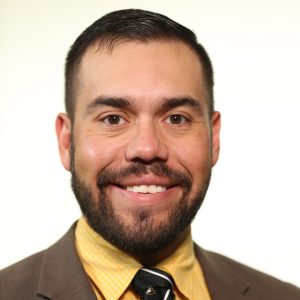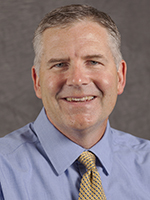Faculty

Dec. 15, 2017
Rebecca North
Research in the North group is focused on addressing the question: What controls algal biomass of inland waters? North’s team focuses on the effects of multiple stressors on nutrient cycling, bioavailability, and primary production in Missouri water bodies with particular attention to the source and timing of nutrient loading and the response of the receiving water body. Ecosystem stressors include, but are not limited to: climate change, landscape modification (i.e., agricultural, urban, and industrial applications), eutrophication, and invasive species (i.e., zebra mussels). North’s research is conceptually driven and applies field, lab, and quantitative approaches to studying issues in watershed and…

Nov. 14, 2017
Noel R. Aloysius
Noel Aloysius’ research and teaching focus on terrestrial hydrology, watershed biophysical processes and environmental informatics. Noel’s research group investigates how climate and weather, landscapes and land management drive precipitation-runoff processes and fate and transport of pollution at field-, watershed- and continental-scale river basins. His group utilizes field observations, long-term hydro-climate data, numerical and statistical models to examine the movement of water, solutes and sediments in response to environmental change and human management. Noel is a member of the Gulf Hypoxia Task Force SERA-46 research group representing the University of Missouri. The SERA-46 group is a consortium of twelve Land Grant…

Nov. 13, 2017
Eric Bailey
Eric Bailey is an Associate Professor and State Beef Nutrition Specialist at the University of Missouri. Bailey holds a Ph.D. in Beef Cattle Nutrition from Kansas State University. Bailey leads applied research on backgrounding and stocker cattle, with an emphasis on management of them on tall fescue pasture systems. Bailey leads the MU Extension Feedlot School program, is co-coordinator of the Missouri Grazing Schools, and the co-director of the Forage-Livestock Program of Distinction. Educational background Ph.D., Kansas State University…

Nov. 10, 2017
Thomas Spencer
Spencer’s laboratory seeks to define critical physiological and genetic pathways that regulate uterine development, function, and regeneration in order to improve reproduction and health of women and animals. His earlier work established that the glands of the uterus are essential for embryo survival and growth using the ovine uterine gland knockout model. Subsequent research revealed fundamental aspects of postnatal uterine development and uterine receptivity as well as illuminated the evolutionary biology and functional role of endogenous retroviruses in placental development. Current research foci in his lab include: cellular and molecular mechanisms governing development of the uterus; maternal and paternal regulation…

Nov. 10, 2017
Christine Elsik
Educational background Ph.D., Genetics, Texas A&M University Courses taught AN_SCI/PLNT_SCI 8430: Introduction to Bioinformatics Programming…

Nov. 10, 2017
Jared E. Decker
IDENTIFYING LOCI RESPONDING TO SELECTIONIn 2012 Decker published a method, now called Generation-Proxy Selection Mapping, to identify loci responding to current selection. In this analysis, birth date (as a surrogate to generation number) is fit as the dependent variable in a mixed model equation. Variants that have changed in frequency rapidly due to selection are strongly associated with birth date, thus the method identifies regions under selection. The mixed model equations correct for demography, relatedness, and population structure within the data. We have previously used this method in Angus cattle using approximately 45,000 SNPs. In 2021, Decker’s group published…

Nov. 3, 2017
Dana Massengale
Educational background Ph.D., University of Nevada, Las Vegas, 2008 M.S., University of Nevada, Las Vegas, 2002 B.S., University of Nevada, Las Vegas, 1993 Courses taught PRT 2080: Global Sport Environments PRT 4385: Legal Aspects of Sport…

Nov. 3, 2017
Patrick S. Market
The morphology and evolution of extratropical cyclones, jet streak-frontal interactions, heavy rainfall and snowfall forecasting, and precipitation efficiency, are primary research areas. Educational background Ph.D. Meteorology, Saint Louis University, 1999 Courses taught Weather Observation Advanced Synoptic Meteorology Numerical Weather Prediction…

Nov. 3, 2017
Anthony Lupo
Lupo, Professor of Atmospheric Sciences, Atmospheric Science Program, University of Missouri (MU). He has a BS in Meteorology (State University of New York at Oswego, 1988), and an M.S. and Ph.D. in atmospheric science (Purdue University, 1991, 1995). His research is in large-scale atmospheric dynamics and teleconnections, climate dynamics and variability, tropical meteorology, and climate change including modeling, and has more than 160 peer-reviewed publications. He is a member of the American Meteorological Society (Certified Consulting Meteorologist [CCM] #660), and the National Weather Association. He was a Fulbright Scholar during summer 2004, AY 2014-2015, and October 2017 to Russia. The…

Nov. 3, 2017
Chung-Ho Lin
Lin is the lead scientist for the bioremediation, natural products and bioanalytical programs at the Center for Agroforestry at University of Missouri. His primary research involves the use of plants, microbes and engineered enzymes for bioremediation, ecological restoration, and development of bioeconomy. His bioremediation research focuses on bioremediation of organic pollutants and human pathogens. Since the COVID19 pandemic in 2020, Dr. Lin has successfully redirected the analytical resources and led his research team joining the task force ‘Coronavirus Sewershed Surveillance Project’ sponsored by the state and federal agencies to provide an early warning and capture the emergence of the…